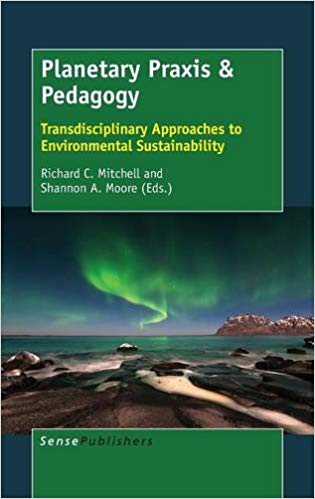Sue L. T. McGregor


This book is edited by Canadians Shannon Moore and Richard Mitchell, both from Brock University in Ontario, Canada. Their edited collection is 150 pages in length with 7 chapters as well as an Introduction and Overview of the Volume. Nearly half (43%, 62 pages) of the book is devoted to two chapters (Chapter 2 Planetary praxis and pedagogy and Chapter 3, Marketing sustainable living). The remaining five chapters average 14 pages each. Each chapter has its own reference list. There is no index (and it would have been good to have one).
The book ends with a profile of the 11 contributors (Canada, Brazil and New Zealand), the majority from three universities in Canada (York, Brock and Toronto). As befitting a book about transdisciplinarity, the contributors have varied backgrounds: biology, education, dramatic arts, environmental studies, women and gender studies, political science, child and youth studies, and marketing. The book “is a final project in a trilogy linking Freirean pedagogies [of hope] with transdisciplinarity” (p.1). At page 3, they clarify that the other projects are also with Sense Publishers (Moore & Mitchell, 2008; Mitchell & Moore, 2012).
The word transdisciplinarity in the title drew me to this book, along with the words pedagogy and praxis. And, you must admit that planetary praxis is a catchy title. By this phrase, they meant “praxis in a planetary context” (p. 1). Praxis is Greek, to do or to act. Praxis is also a term pursuant to the act of engaging, applying, exercising, realizing, or practicing ideas (p. 41). In the case of this book, the idea is to do education differently to ensure the future of the planet (in particular environmental and sustainability education). And the way to do it differently is to draw on transdisciplinarity.
In addition to transdisciplinarity, praxis is the lynch pin of this book. It is a special form of practice and refers to “action which embodies certain qualities. These include a commitment to human well being and the search for truth, and respect for others. It is the action of people who are free, who are able to act for themselves” (Smith, 2011, p.4). This type of practice does not mean performing or doing a task to get better at it; rather, “it is other-seeking and dialogic” (p.4). Praxis is directed at other human beings while being engaged in by human beings. With praxis, there is no prior knowledge of the right way to realize a particular end. As people think about something they want to change, they alter the way they might aim for. As they think about how to achieve it, they change the means. The means and ends are in continual interplay (Smith, 2011). This notion of the process and the solution being alive and changing is a good fit with transdisciplinarity, which assumes that knowledge and problems are alive and changing because the people trying to address the issue are alive and changing as they work together toward new knowledge consolidation (Nicolescu, 2002, 2014).
Without an index, I checked the reference lists in each chapter to see which ones explicitly discussed transdisciplinarity. I found it in three of the seven chapters: Chapter 2, 3 and 6. Mitchell and Moore (chapter 2) confirm they used Professor Dr. Basarab Nicolescu’s notion of transdisciplinarity (in contrast to the Zurich approach, which is referenced in Chapter 3 (see McGregor, 2015, for a comprehensive overview of these two approaches). Chapter 6 drew on the transdisciplinary work of two Canadian scholars. Chapters 7 and 8 were grounded in interdisciplinarity, not transdisciplinarity. In fact, Bazely et al. (p. 127) confusingly said that interdisciplinarity provides opportunities for transdisciplinary thinking. Chapter 5 did not use the word transdisciplinarity, but its focus on creative practice is in the spirit of Nicolescu’s idea that art and creativity are core transdisciplinarity concepts. Chapters 4 and 8 made no mention of transdisciplinarity.
The long and short of it is that anyone wanting to read about planetary praxis and transdisciplinarity should read only Chapters 2, 3 and 6. Chapter 2 reported the results of a study of transdisciplinarity in higher education. Mitchell and Moore identified four approaches universities can take when trying to do transdisciplinarity: (a) transdisciplinary catalyst, (b) transdisciplinary co-opting, (c) transdisciplinary praxis and (d) transdisciplinary entelechy (something that makes actual what is otherwise merely potential). This is a creative way to characterize the various hybrid approaches to transdisciplinarity undertaken by institutions of higher education, and I highly recommend reading it.
In Chapter 3, Varey linked pragmatism with transdisciplinary thinking. Pragmatism (John Dewey) presumes that we cannot have intelligent practice (versus uninformed practice) unless people can theorize. Compared to classical science, pragmatism is organic – emergence, holism, continuity, indeterminism. Nicolescu (2002, 2014) sees transdisciplinarity as a challenge to classical science with Varey making a very convincing and compelling case for the place of pragmatism in transdisciplinary thinking (pp. 45-58).
Chapter 6 (Garramone) linked transdisciplinarity with creative learning processes so that students could “perform critical-place-based pedagogy in our post-human times” (p. 108). She maintained that using transdisciplinarity helped her rethink her curriculum and pedagogy, so students learned to challenge how knowledge has historically been produced, replacing this with the historical and broader relational nature of knowledge.
Despite that only three chapters were truly entrenched in transdisciplinarity, this book is rich with concepts that reflect the essence of transdisciplinarity: integral, complexity, transformation, transcendence, integrated, knowledge flow, knowledge integration, wicked problems, rhizomatic thinking, and humanistic. There are nice, innovative ideas in here as well including knowledge as a nutrient. Although the latter stems from an interdisciplinary initiative (Chapter 7), it is a beautiful idea and truly reflective of the spirit of transdisciplinarity. Ecologically-oriented knowledge can be consumed (i.e., rich with nutrients) leading to enhanced knowledge flow, which in turn leads to increased community resiliency and improved adaptive capacity (see p.122). They claim to be the first to conceptualize “knowledge as a nutrient in the ecosystem” (p. 123).
In a paradox, although the Editors say this volume is about a Freirean pedagogy of hope, they close out their introduction with the lament “Is it too late?” (p.7). I actually came away with a renewed sense of hope knowing that environmental and sustainability education can be enriched with transdisciplinary thinking. I recommend this book for all disciplines because the main message is that drawing on transdisciplinarity expands curricula and pedagogy in such a way that hope is engendered. A title that better reflects this message might be Transdisciplinary Planetary Praxis and Pedagogy. Enjoy the read!
References
McGregor, S. L. T. (2015). The Nicolescuian and Zurich approaches to transdisciplinarity. Integral Leadership Review, 15(3) http://integralleadershipreview.com/13135-616-the-nicolescuian-and-zurich-approaches-to-transdisciplinarity/
Mitchell, R. C., & Moore, S. A. (Eds.). (2012). Politics, participation & power relations: Transdisciplinary approaches to critical citizenship in the classroom and community. Rotterdam, The Netherlands: Sense Publishers.
Moore, S. A., & Mitchell, R. C. (Eds.). (2008). Power, pedagogy and praxis: Social justice in the globalized classroom. Rotterdam, The Netherlands: Sense Publishers.
Nicolescu, B. (2002). Manifesto of transdisciplinarity [Trans. K-C. Voss]. New York, NY: SUNY
Nicolescu, B. (2014). From modernity to cosmodernity. Albany, NY: SUNY.
Smith, M. K. (2011). What is praxis? In M. K. Smith, M. E. Doyle & T. Jeffs (Eds.), The encyclopaedia of informal education. Retrieved from http://www.infed.org/biblio/b-praxis.htm
Richard Mitchell and Shannon Moore. (Eds). (2015). Planetary praxis and pedagogy: Transdisciplinary approaches to environmental sustainability. Rotterdam, the Netherlands: Sense Publishers. ISBN 978-94-6300-212-7 (soft cover, $43.00), ISBN Hardcover: 9789463002134 ($ 99.00), ISBN E-Book: 9789463002141 A free copy of the Introduction is at https://www.sensepublishers.com/media/2452-planetary-praxis-and-pedagogy.pdf
About the Author
Sue L. T. McGregor (PhD, IPHE, Professor Emerita MSVU) is an active independent researcher, analyst and scholar in the areas of transdisciplinarity, home economics philosophy and leadership, consumer policy and education, and research paradigms and methodologies. She recently published Understanding and Evaluating Research (SAGE, 2018). Her scholarship is at her professional website:www.consultmcgregor.com sue.mcgregor@msvu.ca
